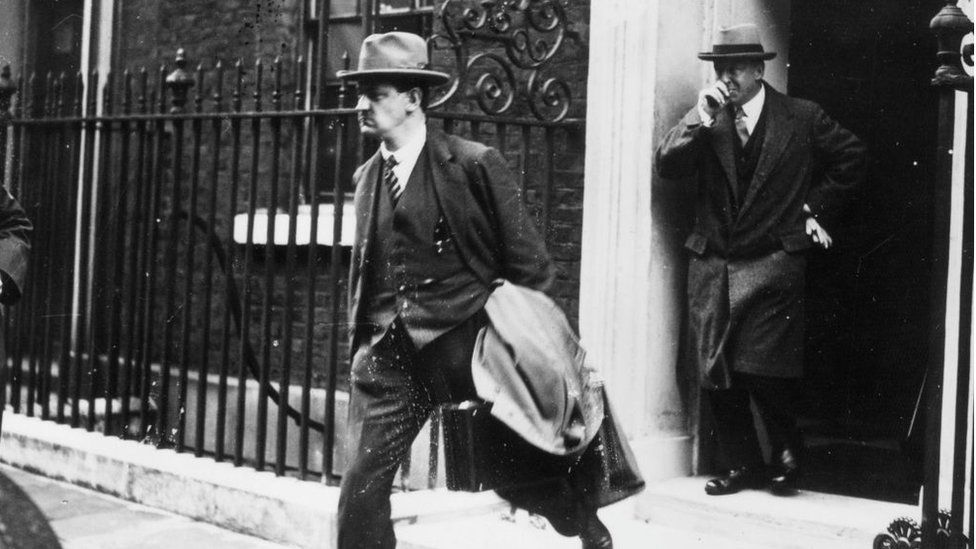NI 100: What was the Anglo-Irish Treaty?
- Published

Michael Collins leaves Downing Street during treaty negotiations
Exactly 100 years ago, after months of negotiations, the British and Irish delegates gathered in the cabinet room of 10 Downing Street in the early hours of the morning and signed the Anglo-Irish Treaty.
The document allowed for the creation of an independent Irish Free State within the British Empire, with King George V as its head of state.
It also confirmed the partition of the island of Ireland and allowed Northern Ireland to remain in existence if its parliament chose.
The treaty was highly controversial and ultimately led to civil war in Ireland between those who supported it and those who opposed it, a war the pro-treaty side eventually won.
So what was contained in the treaty?
A new Irish state
The very first clause in the treaty said Ireland would become known as the Irish Free State and would have the same constitutional status within the British Empire as Australia, Canada, New Zealand and South Africa.
Those countries, known as dominions, had a high level of independence from Britain, but were not fully independent countries as they are today.
The Free State's parliament would have powers "to make laws for the peace, order and good government of Ireland and an executive responsible to that parliament".
Crucially, however, Northern Ireland - which came into existence in May 1921 - would have the option to opt out of this new state, which it ultimately did.
This meant the Free State ended up consisting of 26, not 32, counties.
An oath to the King
This was one of the most controversial aspects of the treaty and many Irish republicans refused to accept it.
The Irish Free State's head of state would be King George V and members of the new country's parliament would have to swear an oath of allegiance to the constitution and fidelity to the king.
Northern Ireland's opt-out
Ireland had been partitioned into two entities - Northern Ireland and Southern Ireland - when the Government of Ireland Act came into effect in May 1921.
The treaty theoretically applied to both parts of the island, but stated that the powers of the parliament and government of the new Free State would not be applicable in Northern Ireland until one month after the acts of parliament needed to ratify the treaty had been passed.
Prayer meetings were held outside Downing Street in London during the Anglo-Irish Treaty negotiations
The treaty also said that before this month had passed the Parliament of Northern Ireland could present an address to the King asking that Northern Ireland be allowed to permanently opt out.
The Parliament of Northern Ireland did just this in December 1922.
Read more about the Anglo-Irish Treaty
If it had not presented an address, Northern Ireland would have continued to exist but as part of the Irish Free State rather than part of the United Kingdom.
The Irish Free State's parliament would have had the power to make laws in any area not explicitly delegated to the Northern Ireland Parliament.
A boundary commission
If Northern Ireland did opt out, a commission was to be set up to finalise the new Irish border.
The border that existed simply followed county boundaries which separated the six counties of Northern Ireland from their neighbours in the south.
The commission was to determine that the border was "in accordance with the wishes of the inhabitants, so far as may be compatible with economic and geographic conditions".
The commission met in 1924-25 but its recommendations were never implemented.
Defence and the Treaty Ports
The treaty stated that until a future agreement was struck, the Royal Navy would continue to have responsibility for the seas around all of Ireland, although the Irish Free State was allowed to have boats necessary for "protection of the revenue or of the fisheries".
Dunree Fort guarded Lough Swilly, one of the Treaty Ports
Some ports were also to remain under British control, with Britain able to obtain others in a time of war.
The ports which remained under British control in peacetime were Spike Island near Queenstown (Cobh), Berehaven and Lough Swilly.
These ports, which became known as Treaty Ports, were handed over to Ireland in 1938.
What happened next?
The treaty had to be ratified by the UK Parliament and "a meeting of members of Parliament elected for constituencies in Southern Ireland since the passing of the Government of Ireland Act, 1920".
Of the 128 members elected in that poll, 124 were Sinn Féin candidates who set up the Second Dáil. It was this assembly that debated the treaty.
The UK House of Commons approved the treaty on 16 December by 401 votes to 58 and, on the same day, the House of Lords voted in favour by 166 to 47.
The Dáil debates were extremely divisive and after 10 days of debate the treaty was passed by a vote of 64 to 57.
This narrow split spilled over into violence and the Irish Civil War between the pro-treaty and anti-treaty sides broke out in June 1922.
The BBC News NI website has a dedicated section marking the 100th anniversary of the creation of Northern Ireland and partition of the island.
There are special reports on the major figures of the time and the events that shaped modern Ireland available at bbc.co.uk/ni100.
Year '21: You can also explore how Northern Ireland was created a hundred years ago in the company of Tara Mills and Declan Harvey.
Listen to the latest Year '21 podcast on BBC Sounds or catch-up on previous episodes.
- Published21 December 2020
- Published22 June 2021
- Published3 May 2021
- Published11 October 2021
- Published6 December 2021